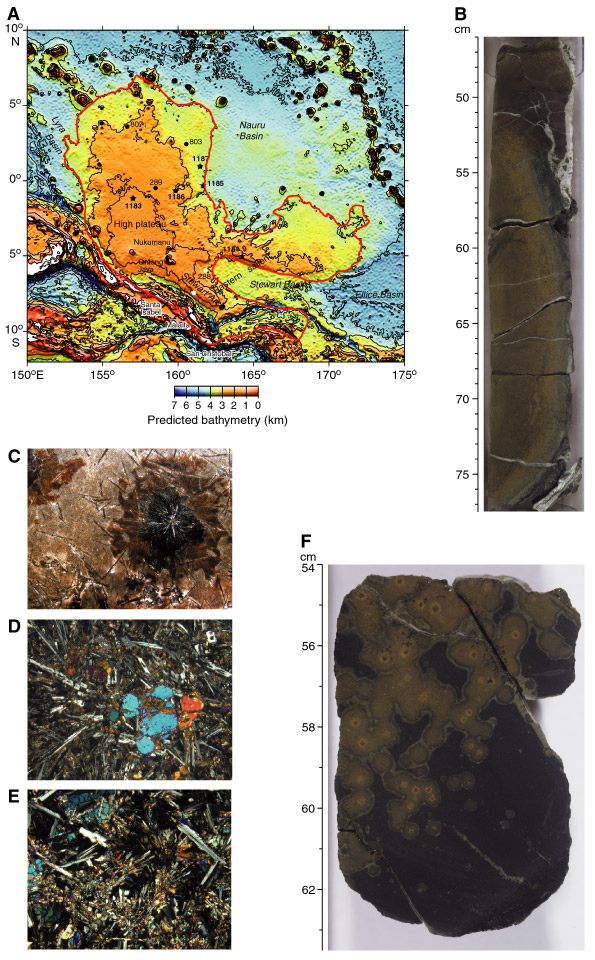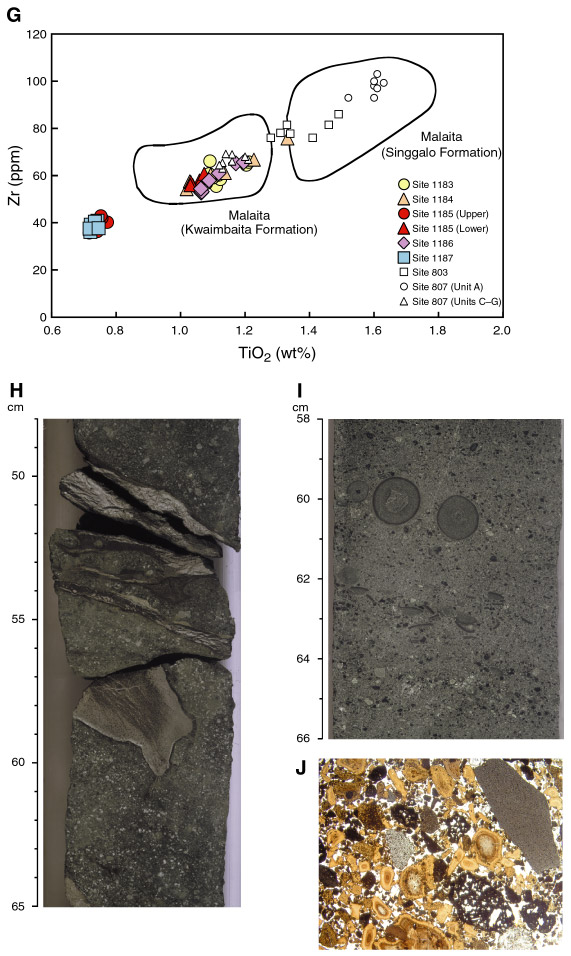
Frontispiece.
A. Predicted bathymetry (after Smith and Sandwell, 1997) of the Ontong Java Plateau (outlined in red) showing the locations of sites drilled during Leg 192 (stars). Previous Ocean Drilling Program (ODP) and Deep Sea Drilling Project drill sites that reached basement are marked by black dots. White dots mark Site 288, which did not reach basement but bottomed in Aptian limestone, and Site OJ-7, which was proposed for Leg 192 but not drilled. The bathymetric contour interval is 1000 m. A larger version is available as the site map for this leg.
B. Close-up photograph of a pillow margin from Site 1187 (interval 192-1187A-11R-1, 46–77 cm), showing an Fe oxyhydroxide–stained spherulitic region parallel to the glassy rim.
C. Photomicrograph showing elongate altered olivine crystals and spherulitic plagioclase crystals in a pillow margin from Site 1185 (Sample 192-1185B-4R-1, 142–144 cm). Field of view = 5.5 mm; plane-polarized light.
D. Unaltered olivine phenocrysts in basalt from a pillow center from Site 1187 (Sample 192-1187A-6R-6, 105–107 cm). Field of view = 2.8 mm; crossed polars.
E. Sprays of plagioclase and augite crystals in a massive flow interior from Site 1186 (Sample 192-1186A-34R-2, 143–146 cm). Field of view = 2.8 mm; crossed polars.
F. Close-up photograph of a spherulitic, high-Mg basalt pillow margin from Site 1185 (interval 192-1185B-3R-1, 54–63 cm). The glassy rim of the pillow is at the lower right.
G. Zr vs. TiO2 for basement rocks recovered at all Leg 192 sites and ODP Sites 803 and 807 (Mahoney et al., 1993). The fields for the Kwaimbaita Formation and the overlying Singgalo Formation on Malaita (Tejada et al., 1996, 2001) are shown for comparison.
H. Close-up photograph of wood fragments in lithic vitric tuff near the base of Subunit IIE at Site 1184 (interval 192-1184A-45R-7, 48–65 cm).
I. Close-up photograph of accretionary lapilli, both whole (round) and fragmented, in gray lithic vitric tuff, Subunit IIA at Site 1184 (interval 192-1184A-14R-1, 58–66 cm).
J. Photomicrograph showing a wide range of lithic and vitric clast types present in a lithic vitric tuff from Subunit IID at Site 1184 (Sample 192-1184A-31R-7, 40–43 cm). The clasts include glass shards (light brown), basalt (gray), and tachylite (dark brown). Plane-polarized light.


References
Mahoney, J.J., Storey, M., Duncan, R.A., Spencer, K.J., and Pringle, M.S., 1993. Geochemistry and age of the Ontong Java Plateau. In Pringle, M.S., Sager, W.W., Sliter, W.V., and Stein, S. (Eds.), The Mesozoic Pacific: Geology, Tectonics, and Volcanism. Geophys. Monogr., Am. Geophys. Union, 77:233–262.
Smith, W.H.F., and Sandwell, D.T., 1997. Global seafloor topography from satellite altimetry and ship depth soundings. Science, 277:1956–1962.
Tejada, M.L.G., Mahoney, J.J., Duncan, R.A., and Hawkins, M.P., 1996. Age and geochemistry of basement and alkalic rocks of Malaita and Santa Isabel, Solomon Islands, southern margin of Ontong Java Plateau. J. Petrol., 37:361–394
Tejada, M.L.G., Mahoney, J.J., Neal, C.R., Duncan, R.A., and Petterson, M.G., in press. Basement geochemistry and geochronology of central Malaita, Solomon Islands, with implications for the origin and evolution of the Ontong Java Plateau. J. Petrol.